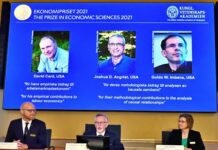
Stockholm: The Royal Swedish Academy of Sciences has awarded the 2023 Nobel Prize in Physics to three scientists who have developed experimental methods to generate extremely short pulses of light, known as attosecond pulses, that can be used to study the dynamics of electrons in matter. The laureates are Pierre Agostini at Ohio State University, US, Ferenc Krausz at the Max Planck Institute of Quantum Optics in Garching, Germany, and Anne L’Huillier at Lund University, Sweden. The announcement was made by Hans Ellegren, Secretary General of the Royal Swedish Academy of Sciences, in Stockholm on Tuesday.
The Nobel Prize in Physics recognizes the contributions of the laureates to attosecond physics, a field that allows researchers to observe and manipulate the motion of electrons within atoms and molecules. Electrons are the fundamental particles that determine the chemical properties and interactions of matter. By creating flashes of light that last only a few billionths of a billionth of a second (10^-18 seconds), the laureates have opened up new possibilities for exploring the world of electrons at the smallest scales and the shortest timescales.
The prize citation states that the laureates have “demonstrated a way to create extremely short pulses of light that can be used to measure the rapid processes in which electrons move or change energy”. The prize committee further explains that “the laureates’ contributions have enabled the investigation of processes that are so rapid they were previously impossible to follow”. For example, attosecond pulses can be used to capture snapshots of electron motion during chemical reactions or to probe how electrons interact with light and magnetic fields.
The Nobel Prize in Physics is one of the most prestigious awards in science. It was established by the Swedish inventor and industrialist Alfred Nobel, who died in 1896 and left his fortune for the creation of annual prizes in physics, chemistry, physiology or medicine, literature, and peace. The prize consists of a gold medal, a diploma, and a cash award of 11 million Swedish kronor (about $1 million).

The Nobel Prize in Physics is the second prize to be announced this week, following the Nobel Prize in Physiology or Medicine on Monday, which was awarded to Katalin Karikó and Drew Weissman for their discoveries that enabled the development of mRNA vaccines against COVID-19. The remaining prizes will be announced in the following days: the Nobel Prize in Chemistry on Wednesday, the Nobel Prize in Literature on Thursday, the Nobel Peace Prize on Friday, and the Sveriges Riksbank Prize in Economic Sciences in Memory of Alfred Nobel on Monday, October 9. The laureates will receive their awards at ceremonies on December 10, the anniversary of Nobel’s death.


















































